
Westgate is a community within the Hilltop area of Columbus, Ohio. It was partially constructed on land that formerly housed the American Civil War Camp Chase and a Confederate prison. After the Civil War, the land was purchased by Joseph Binns and his associates with the intent to start a Quaker community. These plans failed to materialize and the land was developed as a "streetcar suburb" in the 1920s. Located 4 miles (6.4 km) west of downtown, the neighborhood is home to Westgate Park and Recreation Center, Westgate Alternative Elementary School, St. Mary Magdalene Church and school, and Parkview United Methodist Church. 4,500 residents live within the Westgate boundaries, most in single family houses.

Franklinton is a neighborhood in Columbus, Ohio, just west of its downtown. Settled in 1797, Franklinton is the first American settlement in Franklin County, and was the county seat until 1824. As the city of Columbus grew, the city annexed and incorporated the existing settlement in 1859. Franklinton is bordered by the Scioto River on the north and east, Harmon Avenue on the east, Stimmel Road and Greenlawn Avenue on the south, and Interstate 70 on the west. Its main thoroughfare is West Broad Street, one of the city's two main roads.

Columbus City Schools, formerly known as Columbus Public Schools, is the official school district for the city of Columbus, Ohio, and serves most of the city. The district has 46,686 students enrolled, making it the largest school district in the state of Ohio as of June 2021. At its peak during the 1971 school year the district served 110,725 students.

Italian Village is a neighborhood in Columbus, Ohio, that contains an array of residential, commercial, and industrial buildings. It is a designated historic district, known for its historical and cultural preservation. The building types and architecture reflect Italian influence. With its parks and preserved historic homes, Italian Village has the highest home value appreciation in Columbus.

Downtown Columbus is the central business district of Columbus, Ohio. Downtown is centered on the intersection of Broad and High Streets, and encompasses all of the area inside the Inner Belt. Downtown is home to most of the tallest buildings in Columbus.
Columbus, the state capital and Ohio's largest city, has numerous neighborhoods within its city limits. Neighborhood names and boundaries are not officially defined. They may vary or change from time to time due to demographic and economic variables.
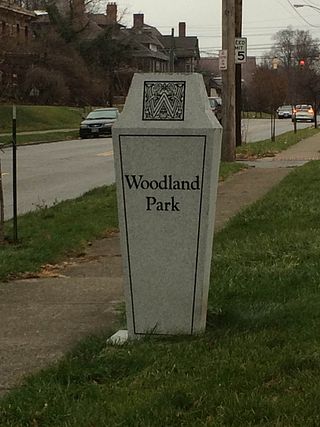
Woodland Park is a residential neighborhood located in the Near East Side of Columbus, Ohio that houses approximately 1,500 residents. The neighborhood was previously home to such figures as artist Emerson Burkhart, cartoonist Billy Ireland, and judge William Brooks. Established in the early 20th century, Woodland Park has grown from its planned neighborhood roots into a modest neighborhood that contains various faith communities, schools, sources of entertainment and recreation, and borders an extension of the Ohio State University medical center.

The Toledo and Ohio Central Railroad Station, today named Station 67, is a union meeting space and event hall located in Franklinton, near Downtown Columbus, Ohio. Built by the Toledo and Ohio Central Railroad from 1895 to 1896, it served as a passenger station until 1930. It served as an office and shelter for Volunteers of America from 1931 to 2003, and has been the headquarters of International Association of Fire Fighters Local 67, a firefighters' union, since 2007. The building was placed on the National Register of Historic Places in 1973. During its history, the building has experienced fires and floods, though its relatively few owners have each made repairs and renovations to preserve the building's integrity. The building is the last remaining train station in Columbus.

Engine House No. 6, also known as the East Franklinton Engine House, is a former Columbus Fire Department station in the East Franklinton neighborhood of Columbus, Ohio. The building was constructed in 1892, designed in the Romanesque Revival style by John Flynn. The station was decommissioned in 1966, and served as an electronics store from 1975 to 2014. It was listed on the National Register of Historic Places in 2016, accompanying planned renovations. The station has been planned to be sold since about 2016, originally to the Columbus Historical Society and Heritage Ohio, though the latter organization now plans to move to the Ohio History Center. The historical society acquired the building in November 2021, and is restoring it with plans to turn it into the city's first permanent local history museum.

The Downtown YMCA is a historic former YMCA building in Downtown Columbus, Ohio. It was the largest YMCA resident facility in the United States. It was listed on the National Register of Historic Places in 1993. The seven-story building was designed in the Jacobethan Revival and Late Gothic Revival styles by Chicago architecture firm Shattuck & Layer.

The Columbus Civic Center is a civic center, a collection of government buildings, museums, and open park space in Downtown Columbus, Ohio. The site is located along the Scioto Mile recreation area and historically was directly on the banks of the Scioto River.
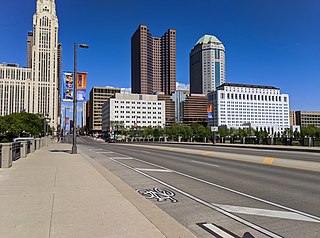
Broad Street is a major thoroughfare in Central Ohio, predominantly in Franklin County and Columbus. It stretches east from West Jefferson at Little Darby Creek to Pataskala. The street is considered one of Columbus's two main roads, along with High Street.
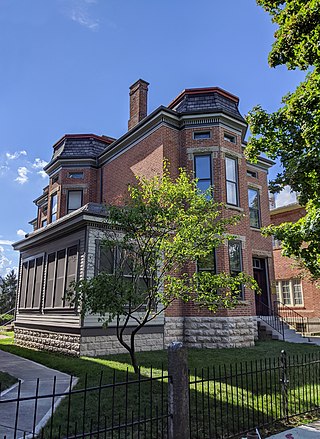
The Columbus Landmarks Foundation, known as Columbus Landmarks, is a nonprofit historic preservation organization in Columbus, Ohio. The foundation is best-known for its list of endangered sites in the city and its annual design award, given to buildings, landscapes, and other sites created or renovated in Columbus. It was established in 1977 as a project of the Junior League of Columbus, Ohio, following the demolition of the city's historic Union Station. It is headquartered at 57 Jefferson Avenue, a contributing structure in the Jefferson Avenue Historic District in Downtown Columbus.

The Charles S. Barrett Building is a historic building in the Merion Village neighborhood of Columbus, Ohio. It was listed on the Columbus Register of Historic Properties in 2006 and the National Register of Historic Places in 2015. The building was completed in 1900 as the home of the city's South High School, part of the Columbus Public School District. It has since been converted into apartments, rented out as The Barrett.
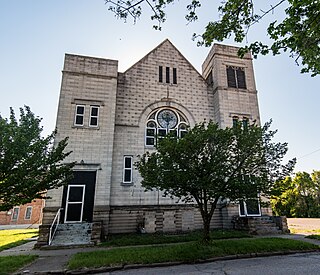
The West Side Spiritualist Church was a historic church building in Franklinton, Columbus, Ohio. The Spiritualist church was built in 1912 for the congregation of Harry Boerstler, who moved to the neighborhood in 1900 to bring hope to its working-class people. The congregation lasted until about 1948, and the building later housed the Boerstler Memorial Spiritualist Temple and the Greater Christ Temple Apostolic Church. After years of vacancy, the church building was approved to be demolished for affordable housing, to accompany an upscale mixed-use development nearby, despite opposition from preservationists.
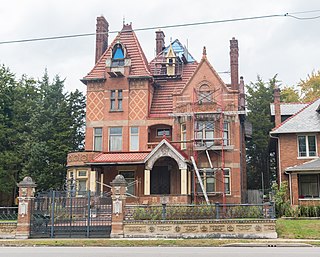
The Charles Frederick Myers house is a historic private residence in the Franklin Park neighborhood of Columbus, Ohio. The house was built in 1896 in an eclectic style. It was added to the Columbus Near East Side District in 1978, and the Bryden Road District in 1990.

The Bellows School, also known as the Bellows Avenue Elementary School, is a historic school building in the Franklinton neighborhood of Columbus, Ohio. The building was constructed for the Columbus Public School District in 1905, designed by local architect David Riebel and built by George Bellows Sr. The elementary school operated until 1977; since then the building has been mostly vacant. The building was deemed eligible for the National Register of Historic Places by the Ohio Historic Preservation Office in 2006. In 2014, a developer announced plans to renovate the structure, despite plans from Ohio's transportation agency to demolish it to expand nearby highway exit ramps.

The 1840 Franklin County Courthouse was the first permanent courthouse of Franklin County, Ohio in the United States. The building, located in the county seat of Columbus, stood from 1840 to 1884. The building was replaced with another county courthouse in 1887, and after its demise, that courthouse was replaced with Dorrian Commons Park, open from 1976 to 2018; the courthouse moved to a new building nearby. The site is now planned to host the Franklin County Municipal Court.
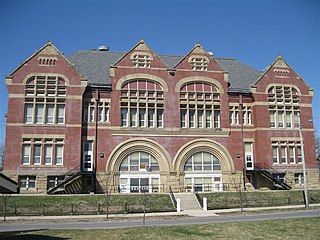
Medary Avenue Elementary School is a school building in the Old North Columbus neighborhood of Columbus, Ohio. The building was constructed in 1892 and was designed by prolific school architect David Riebel.

Beck Street School is a school building in the Schumacher Place neighborhood of Columbus, Ohio. The building was constructed in 1884 and was designed by prolific school architect David Riebel. The school was recognized as one of Columbus's historically significant schools, in a 2002 report by the Columbus Landmarks Foundation.























